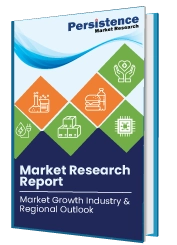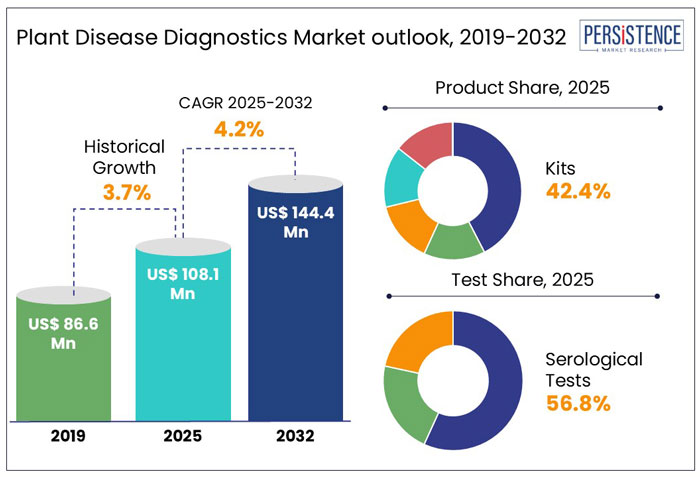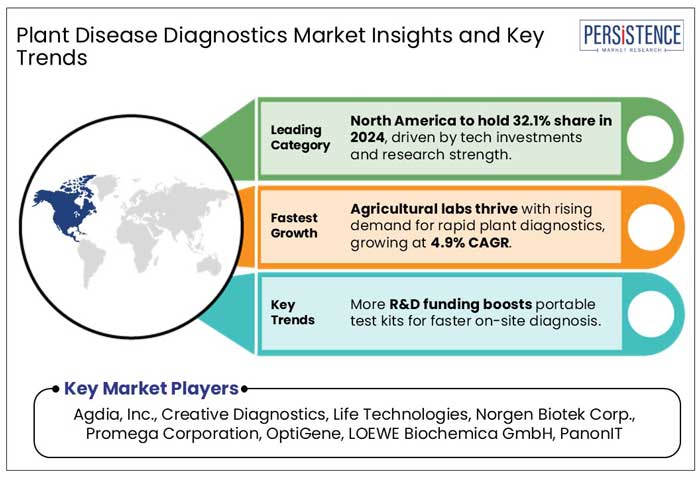ID: PMRREP32741| 236 Pages | 24 Feb 2025 | Format: PDF, Excel, PPT* | Healthcare

Worldwide revenue from the plant disease diagnostics market is estimated to reach around US$ 108.1 Mn in 2025, with the global market estimated to surge ahead at a CAGR of 4.2% to reach a valuation of US$ 144.4 Mn by the end of 2032.

|
Attributes |
Key Insights |
|
Plant Disease Diagnostics Market Size (2025) |
US$ 108.1 Mn |
|
Projected Market Value (2032) |
US$ 144.4 Mn |
|
Global Market Growth Rate (2025-2032) |
4.2% CAGR |
|
Market Share of Top 5 Countries |
51.4% |
As assessed by Persistence Market Research, kits are expected to hold a market value of US$ 45.8 Mn by 2025. Overall, plant disease diagnostics market sales account for approximately 1.2% revenue share in the global agricultural microbials market, which was valued at around US$ 8.7 Bn in 2023.
The global market for plant disease diagnostics recorded a historic CAGR of 3.7% in the last 5 years from 2019 to 2024.
Global temperatures are expected to increase by 2 to 4 °C during the next 100 years as a result of rising CO2 and O3 levels. Additionally, it is expected that extreme weather conditions like drought, heat waves, and unpredictable rainfall patterns will increase in frequency.
Different aspects of global agriculture will be impacted by climate change in different ways. Crop productivity in tropical areas will suffer from rising temperatures. Crop production may no longer be feasible in marginal semi-arid regions of sub-Saharan Africa and South Asia due to heat and drought.
However, extended growing seasons brought on by rising warmth may boost food productivity in temperate regions. Additionally, some climatic changes could have an impact on the diseases that lead to agricultural losses.
The amount of information on how climate change is projected to impact plant diseases has grown significantly in recent years. The majority of these publications forecast that some pathogens would move to new areas, outbreaks will become more often, and plant diseases will likely become more severe. The literature on this topic indicates that a significant number of challenges confront agricultural research, which must adapt to these potential changes. It also draws attention to the uncertainty surrounding where, when, and whether plant diseases will worsen, leading to larger crop losses and endangering the production of food in the future, particularly in the second half of the century. The majority of publications reach the conclusion that substantially more research and funding are considered necessary.
The management of polycyclic diseases depends on the early diagnosis of pathogenic infections. Primary infections typically happen at the start of the growing season, but secondary infections, which are carried by vectors, lead to an irreversible, symptomatic disease stage and a corresponding loss in production.
Before manifesting themselves the following season, several pathogens survive the winter dormant inside plants. By focusing on the host, volatile-based approaches may be able to spot early infections before primary illnesses become obvious. When a virus enters the host before symptoms appear, an induced stress response happens. Before the pathogen reaches thresholds for molecular or serological detection, early-generated volatiles may allow for early disease diagnosis.
Lateral flow microarrays that focus on pathogen- and host-specific biomarkers can be used to detect infections at the first sites. Biophotonic and phage display sensors may enable early detection before the onset of secondary illnesses.
In comparison to conventional nucleic acid and serological assays, other cutting-edge approaches like remote sensors and spectroscopy-based technologies may speed diagnosis and facilitate greater interpretation of the spatial and temporal variability of disease, particularly when calibrated and coupled with reliable reference data. These technological developments will meet the demand for earlier detection and more accurate outcomes, which will boost market expansion.
The global market is thus likely to show high growth over the coming years at a CAGR of 4.2% and reach a global market size of US$ 144.4 Mn by 2032.
What Factors will Drive the Market to Grow over Forecast Duration?
“Innovations in Point-of-Care Diagnostics”
In an attempt to minimize the substantial losses in agricultural output brought on by plant diseases, point-of-care diagnostic technologies for plant pathogen detection with high multiplexing ability are invaluable. For these diagnostic assays, high sensitivity, specificity, reproducibility, efficiency, cost-effectiveness, and multiplex detection capabilities at high throughput are the most desired properties.
Multiple illnesses cause significant annual losses in agricultural production, and developing nations are particularly affected by this issue, placing a high focus on crop disease control in their agriculturally based economies. The best course of action is to identify pathogenic organisms in the field as quickly and efficiently as possible and prevent the emergence of the disease when resistant variants are not viable.
Therefore, the availability of rapid, precise, and targeted diagnostic techniques is crucial for the success of many integrated pest management schemes. To successfully deploy the required solutions and protect agricultural systems, it is critical to develop more effective technologies for crop disease detection and linking them to decision-making authorities.
Is there Any Impact on the Growth of the Plant Disease Diagnostics Market?
“High Cost and Limitations of Current Procedures”
The visual interpretation of symptoms and the study of the pathogens' physical traits through their growth on particular culture media or through observation with microscope techniques are the first methods to stop the spread of plant diseases and impose quarantine restrictions.
Poor reliability and application are general issues with these procedures despite their ease of use and low cost, particularly in the case of pathogens that cannot be grown in-vitro or are challenging to observe under a microscope.
Additionally, it is also vital to remark concerning limitations of antibody-based bio sensing for detection of plant diseases, despite the fact that their mechanisms, economic advantages, and applications have been recognized.
Since many antibodies-based biosensors concentrate on specialised binding with a specific antigen, problems like exposing a microbe to environmental stress could result in measurement errors.
Furthermore, the detection may be hampered by the immobilisation of large fungi and bacteria. More importantly, as antibodies are susceptible to deterioration over time and are simple to denature, they must be stored in a certain environment to prevent this from impairing the behaviour of antibody-based sensors.
Additionally, PCR has demonstrated its capacity to identify plant diseases with great sensitivity when it comes to direct pathogen detection approaches. However, it necessitates the creation of specialized primers to amplify DNA for accurately detecting pathogens. Only high-value target analytes and laboratory setups are thus appropriate for this approach due to its prohibitive cost.
Why is the North America Market Booming?
“Growing Demand for Natural Food Ingredients and Rising R&D Efforts”
North America accounted for around 42.1% of the global market share in 2024. Rising research and development efforts, regulated diagnostic labs, the existence of major industry players, and the widespread use of enhanced assay technologies are all contributing factors to the industry's expansion.
Moreover, with growing emphasis on plant based foods, as well as consumer preference for organic or natural food ingredients within the country, the global market for plant disease diagnostics is gaining traction in the U.S.
Will Europe Be a Lucrative Market for Diagnostic Kits Manufacturers?
“Presence of Federal Online Disease Tracking and Update Program”
Europe held around 28.9% market share of the global plant disease diagnostics market in 2024. With the growth in the formation of regulations in the field of plant disease diagnostics, the market within the country is expected to be driven by the presence of the German federal extension services. They offer an integrated plant protection online information system.
Plant disease surveillance, such as that for potato late blight, is one of the essential components. The monitoring findings are linked to the regional extension officer's remarks about the current condition, as well as to the geographic and agricultural details of the monitoring locations and automatically generated prognosis models for certain infections. Regional extension officers do the monitoring, and the results are instantly uploaded to the internet.
Farm owners and other agricultural personnel can utilise information to assess the disease status in their region. This ensures agricultural vitality and thus propels demand within the region.
How is East Asia Emerging as a Prominent Market for Plant Disease Diagnostics?
“Practicing Elimination Methods to Control Plant Disease”
East Asia held a market share of about 12.4% of the global plant disease diagnostics market in 2024. One of the successful instances of using an elimination method to control a plant disease, such as wheat stem rust in China, is what is driving the market's expansion in that country.
Despite widespread application of chemical pesticides and important resistant types, several significant epidemics of the disease struck winter wheat in Fujian Province, southern China, and spring wheat in Northeast China between 1948 and 1965.
Wheat stem rust was caused by Puccinia graminis var. tritici, according to an investigation. Since the removal of these P. graminis tritici overwintering sites by convincing the farmers to switch from cultivating winter wheat to potatoes and broad beans, there have been no significant outbreaks of wheat stem rust.
Instances of control of other such plant disease epidemics have been recorded in the country, thus propelling the growth of the overall market within China.
Which Product is Driving Growth of the Global Market?
“Varied Range of Applications”
The kits segment held around 42.4% share of the total plant disease diagnostics market in 2024. In order to undertake disease analysis in plants, provide immediate solutions outside the laboratory, and accomplish timely detection, meet surveillance objectives, and minimize major production losses, point-of-care (POC) diagnostic tools or kits are essential.
POC testing will be the deciding factor in management decisions, making it clear whether to begin treatment or when a confirmation test is warranted. POC kits can help with disease control initiatives such as monitoring farm animals, managing their health, and identifying plant pathogens.
Which Test is Largely Preferred for the Plant Disease Diagnostics Globally?
“Applicability of Traditional Methods, and Emergence of ELISA-Based Serological Tests”
Serological tests hold a market share of around 56.8% in 2024. There are numerous serological assays that can be used to identify and detect plant viruses. Traditional techniques like chloroplast agglutination, microprecipitin, tube precipitin, and gel diffusion require close examination of particular virus and antibody precipitates in liquid media or agar gels.
Enzyme-linked immunoassays have superseded conventional techniques. For the identification and assay of plant viruses, many ELISA formats, including direct antigen-coated (DAC)-ELISA, double-antibody sandwich (DAS)-ELISA, F (ab) 2-ELISA, and plate-trapped ELISA, are frequently utilised. Antiserum usage is very cost-effective, and it may be adjusted for extensive testing and quantitative assessment.
Which Sample is Widely Used for Plant Disease Diagnostics?
“Complete Plant Body as Sample in Cases of Unidentified Disease Pathogen”
Plants as sample hold a market share of around 41.1% in 2024. For the testing and identification of plant diseases, the sample includes the whole plant body, in cases where the source of emergence of disease is not identified. Several regulatory bodies recommend how plant samples must be stored for laboratory diagnosis of samples, in order to identify the pathogen of concern.
Which End User Offers the Global Market a Profitable Outlook?
“Assisting Farmers and Plant Producers with Disease Detection and Control”
Agricultural laboratories hold a larger share of about 28.6% with a market value of around US$ 30.9 Mn in 2024. The major goal of agricultural laboratories is to help farmers and plant producers diagnose plant health issues that are affecting agricultural production efficiently and to offer long-term plant health management solutions. This covers, among other things, the detection of pest problems, nutritional inadequacies, and disease-causing agents. Given the light of emerging plant pathogens, the segment holds a greater value share, owed to the provision of thorough disease analysis and control.

Companies within the plant disease diagnostic market are developing innovative technologies like rapid test kits capable of detecting multiple plant diseases in minutes. Thus, helping reduce crop damage and enhances agricultural productivity. Furthermore, research-driven funding is significantly contributing to market growth, as institutions receive financial support to investigate plant diseases and develop improved diagnostic solutions.
Likewise, accreditation programs and regulatory bodies are also shaping the landscape by providing official recognition to laboratories and testing facilities, fostering trust and encouraging further advancements in plant health diagnostics. The combination of technological progress and strategic partnerships is intensifying competition in the sector.
Key instances include:
The global market is currently valued at around US$ 108.1 Mn in 2025.
Sales of the market are set to witness growth at a CAGR of 4.1% and be valued at around US$ 144.4 Mn by 2032.
Demand for the market increased at a 3.7% CAGR from 2019 to 2024.
|
Attribute |
Details |
|
Forecast Period |
2025-2032 |
|
Historical Data Available for |
2019-2024 |
| Market Analysis Units | Value: US$ Bn/Mn, Volume: As applicable? |
|
Key Countries Covered |
|
|
Key Market Segments Covered |
|
|
Key Companies Profiled |
|
| Report Highlights |
|
|
Customization & Pricing |
|
Product:
Test:
Sample:
End User:
Region:
Delivery Timelines
For more information on this report and its delivery timelines please get in touch with our sales team.
About Author